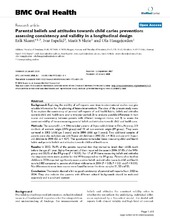| dc.contributor.author | Skaret, Erik | en_US |
| dc.contributor.author | Espelid, Ivar | en_US |
| dc.contributor.author | Skeie, Marit Slåttelid | en_US |
| dc.contributor.author | Haugejorden, Ola | en_US |
| dc.date.accessioned | 2014-11-07T08:39:44Z | |
| dc.date.available | 2014-11-07T08:39:44Z | |
| dc.date.issued | 2008-01-23 | eng |
| dc.identifier.issn | 1472-6831 | |
| dc.identifier.uri | https://hdl.handle.net/1956/8720 | |
| dc.description.abstract | Background: Exploring the stability of self-reports over time in observational studies may give valuable information for the planning of future interventions. The aims of the present study were: 1) to explore the consistency of parental self-reports of oral health habits, beliefs and attitudes towards child oral health care over a two-year period; 2) to evaluate possible differences in item scores and consistency between parents with different immigrant status; and 3) to assess the construct validity of items measuring parental beliefs and attitudes towards child oral health care. Methods: The sample (S1, n = 304) included parents of 3-year-old children in Oslo, Norway; 273 mothers of western origin (WN-group) and 31 of non-western origin (IM-group). They were surveyed in 2002 (child age 3 years) and in 2004 (child age 5 years). Two additional samples of parents were also included; one with 5-year old children in 2002 (S2, n = 382) and one with 3-yearold children in 2004 (S3, n = 427). The questionnaire included items measuring child oral health habits and parental beliefs and attitudes towards child oral health care. Results: In 2002, 76.8% of the parents reported that they started to brush their child's teeth before the age of 1 year. Eighty-five percent of them reported the same in 2004; 87.0% of the WN-group and 33.3% of the IM-group (P < 0.001). For 17 of 39 items measuring beliefs and attitudes the responses were more positive for the WN-compared to the IM-group. Parents of caries-free children in 2004 reported significantly more positive beliefs and attitudes towards child oral health care in 2002 compared to parents of children with caries in 2004 (P < 0.05, P < 0.01 and P < 0.001). No differences in mean item scores were found between the three samples S1, S2 and S3. Conclusion: The results showed a fair to good consistency of parental self-reports from 2002 to 2004. They also indicate that parents with different cultural backgrounds should be evaluated separately and in a cultural context. | en_US |
| dc.language.iso | eng | eng |
| dc.publisher | BioMed Central | eng |
| dc.rights | Attribution CC BY | eng |
| dc.rights.uri | http://creativecommons.org/licenses/by/2.0 | eng |
| dc.title | Parental beliefs and attitudes towards child caries prevention: Assessing consistency and validity in a longitudinal design | en_US |
| dc.type | Peer reviewed | |
| dc.type | Journal article | |
| dc.date.updated | 2013-08-28T17:06:50Z | |
| dc.description.version | publishedVersion | en_US |
| dc.rights.holder | Copyright 2008 Skaret et al; licensee BioMed Central Ltd. | |
| dc.rights.holder | Erik Skaret et al.; licensee BioMed Central Ltd. | |
| dc.source.articlenumber | 1 | |
| dc.identifier.doi | https://doi.org/10.1186/1472-6831-8-1 | |
| dc.identifier.cristin | 365081 | |
| dc.source.journal | BMC Oral Health | |
| dc.source.40 | 8 | |

